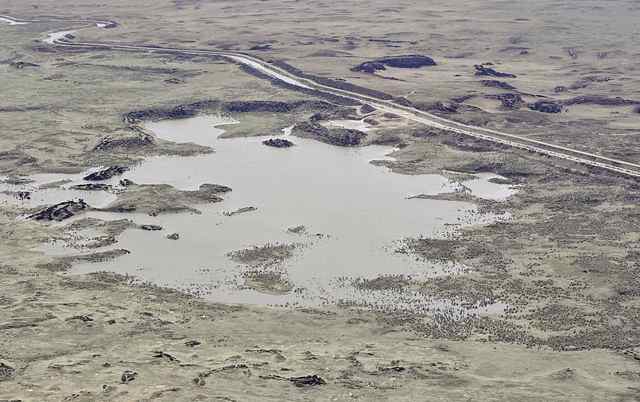forum
library
tutorial
contact

Eastern Snake Plain Aquifer
Recharge Shatters Record
by Carol Ryan Dumas
Capital Press, April 4, 2018
|
the film forum library tutorial contact |

|
Eastern Snake Plain Aquifer
by Carol Ryan Dumas
|
As of March 22, the Idaho Water Resource Board had sent nearly
360,000 acre-feet of water flowing back to the Eastern Snake Plain Aquifer.
 An abundance of water is allowing the Idaho Water Resource Board to up its game on recharging the Eastern Snake Plain Aquifer following last year's record recharge.
An abundance of water is allowing the Idaho Water Resource Board to up its game on recharging the Eastern Snake Plain Aquifer following last year's record recharge.
The board now estimates recharge efforts will return 440,000 acre-feet to the aquifer by the end of the current water year.
The new projection is well above the 370,000 acre-feet estimated a month ago and the record 317,000 acre-feet recharged last year.
"It's absolutely fantastic," Wesley Hipke, the board's recharge program manager, said on Wednesday.
Recharge broke the record last year and is breaking records every day here on out as long as there is available water, he said.
"These have been two great years," he said.
As of Wednesday, he's been able to recharge 210 days, well above the average 150 days in the Lower Snake region and 30 days in the Upper Snake region.
"Mother Nature has been very kind to us," he said.
This year's efforts began about two months early at the end of August with 61,000 acre-feet of surplus water donated by the Surface Water Coalition. A warm fall allowed recharge to continue until mid-December.
Typically, recharge has to back off earlier than that due to freezing conditions in canals, Hipke said.
Temperatures increased early after the first of the year, and recharge resumed. The Fremont-Madison Irrigation District in eastern Idaho has even been able to recharge continuously all season in some of its canals, he said.
Cool spring weather is also helping, keeping snow in the mountains -- which allows water to be released slowly from reservoirs at a steady pace, he said.
"If it comes out in a big rush, it overwhelms the recharge capacity, and then it's gone. And then there's no excess water for recharge," he said.
The cool spring is also reducing projected demand for irrigation water.
"With flows in the river, there's a lot of water available to recharge," he said.
Water for recharge from the Bureau of Reclamation above the Milner Dam will probably be available through April, but it really depends on irrigation demand, Corey Loveland, the agency's water operations manager in the Upper Snake field office, said.
"It potentially could go into May but at this time, it's hard to guess," he said.
If temperatures warm up strong, it'll be used on fields and not for recharge, he said.
As of March 22, the board had recharged a total of 359,712 acre-feet.
That included 145,859 acre-feet in the Upper Snake region, 210,842 acre-feet in the Lower Snake Region, and 3,011 acre-feet in the Big/Little Wood River region below Magic Reservoir.
The board's goal is to recharge an average of 250,000 acre-feet a year.
It's been a great couple of years, but there's more work to do, Hipke said.
In dry years, only about 150,000 acre-feet of water is available for recharge. While recharge will top 400,000 acre-feet this year, additional recharge capacity is needed to capture even more water in the wet years to help out with those drier years, he said.
learn more on topics covered in the film
see the video
read the script
learn the songs
discussion forum
